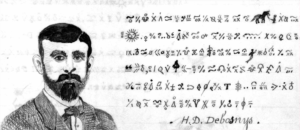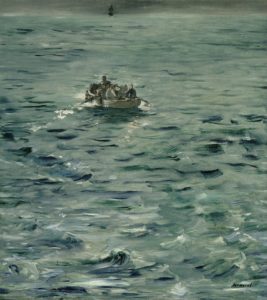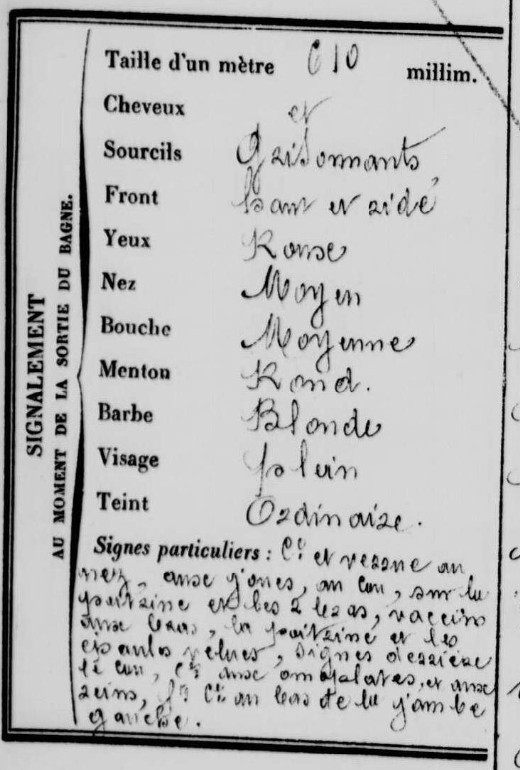I recently posted about my search for Edouard Keff, and noted that it was possible that he might have been born in Chateaurouge as a brother of Jean Keff and Pierre Keff whose troubled (bagnard) histories I had previously found.
As part of all this, I ended up doing my best to reconstruct the Keff family tree, something which no genealogist on filae.com or on Geneanet.org seems to have managed particularly well. However, I should point out that a good part of this was probably because they often rely on specialised town / area genealogical studies, where groups of volunteers comb through a locality’s birth / baptism / marriage (and sometimes divorce) / death registers, and then use that to try to assemble local family trees.
Because geographical mobility was (for the most part) traditionally low, this – as a genealogical rule of thumb – makes plenty of practical sense. But for more mobile families (like the one that Jean & Pierre Keff were born in), you end up with different localised fragments of genealogy in different places that don’t quite connect up with each other. As you’ll see, the Keff famille moved from Hombourg-Haut, Moselle to Chateaurouge, Moselle, to Bouzonville, Moselle, to Paris.
The parents of the Keff family
- Pierre Marie Keff: b. 21 Aug 1801, Hombourg, Moselle, to Jean Keff & Eve Weiss; d. 29 Aug 1848, Paris 5e Arrondissement
- Catherine Andre: b. 10 Oct 1805 to Pierre Andre and Anne Marie Hamann, died 1894, Paris 15e Arrondissement.
- Married: 20 Oct 1830, Hombourg-Haut, Moselle.
Their children
- Jean Keff: b. 1830 Hombourg Haut, d. 1830
- Jean Michel Keff: b. 23 Sep 1831, Hombourg Haut; d. 05 July 1853, Terre-de-Haut, Guadeloupe
- Pierre Keff: b. 13 May 1833, Chateaurouge; d. 15 Jun 1911, Paris
- Catherine Keff: b. 03 Apr 1835, Chateaurouge; [death unknown]
- Marguerite Keff: b. 15 May 1837, Bouzonville; d. 13 Jan 1843, Bouzonville
- Therese Keff: b. 02 Apr 1839, Bouzonville; d. 1894, Paris
- Jean Keff: b. 25 July 1841, Bouzonville; d. 10 Feb 1894, Ile Nou, Nouvelle Caledonie
- Elisabeth Keff: b. 11 Apr 1843, Bouzonville; d. [“Elise Keff”] 27th April 1849, Paris, 5e Arrondissement
- Madelaine Keff: b. Jan 1844, Bouzonville; d. 13 January 1844
- Joseph Keff: b. 30 Apr 1845, Bouzonville; d. 19 Jan 1846
- Nicolas Keff: b. 12 Feb 1848; d. 28 Apr 1849 Paris, 5e Arrondissement
Their grandchildren
Therese Keff married Joseph Claude Branciard (theatre director) [b. ~1836].
- No children (as far as I can see)
Pierre Keff married Catherine Birschens. They had two children:
- Victorine Josephine Keff: b. 27 Nov 1864; d. 03 May 1865
- Josephine Catherine Keff: b. 21 Jun 1863, Paris; d. 14 Mar 1944, Paris
Jean Keff married Reine Lichtenberger. They had four children:
- Leon Pierre Jean Keff: b. 20 Feb 1865, Paris; d. 27 Feb 1900, Paris (as “Pierre Jean Leon Keff”)
- Pierre Jean Baptiste Keff: b. 20 Jun 1866, Paris; [but then disappears]
- Jules Joseph Keff: b. Jun 1866 (?); d. 9th Mar 1869 [aged 2 years 9 months]
- Anais Keff: b. 24 Feb 1869, Paris; d. 06 May 1887, Paris
Note that Pierre Jean Baptiste Keff and Jules Joseph Keff seem to have been born at almost exactly the same time: which I think means that they were either (a) twins, or (b) the same child but with two different names (we have a birth day for one and a death day for the other). I suspect that the latter of these two scenarios is the more likely.
Their great-grandchildren
Josephine Catherine Keff married Victor Pierre van de Casteele, but:
- No children (as far as I can see)
At which point the entire Keff family tree seems to just disappear. 🙁
Note that Victor Pierre van de Casteele was born in Brest on 13 Sep 1847; married Mathilde Judith Jeanne Delphine RACQUE (RAQUE) in 1880 (they divorced in 1892); and died in Paris 14e Arrondissement in 1926 aged 79, or in Paris 20e Arrondissement in 1930 aged 83 (I’m not sure which of the two is correct). So it seem highly likely to me that he would have married Josephine Catherine Keff (16 years younger than him) in 1892 or later.
Are there any loose ends?
Jean Michel Keff, born in 1831, died as a 21-year-old marine infantryman in l’Hopital des Saintes on an island in the Guadeloupe archipelago. Note the main feature of this island was a military prison: so it’s entirely possible that he was in prison there, possibly for desertion (it was common at this time for young French military to try to run away to America). I also suspect that he may have joined the marines once his father died in 1848.
For Pierre Keff born in 1833, having served his sentence in Nouvelle Caledonie (which extended slightly for trying to escape), he was released in 11 Aug 1889. At his death, he was described as a widower of Catherine Derichelle (is that a Belgian surname?), but I have found no mention of any children.
For Catherine Keff born in 1835, there seems no mention of her as an Optant in 1872 (as part of the fallout from the Franco-Prussian War, people from the Moselle etc had to publicly declare their allegiance). And there is also no sign of marriage etc. Hence my suspicion here is that she simply died young and failed to get listed (there are some glaring holes in the Chateaurouge register, which makes me think that a number of pages got lost along the way).
Finally: I have worked hard to try to find any trace of Leon Pierre Jean Keff (1865-1900) beyond his birth and death, but have so far found nothing. He was an “imprimeur”, died while living at Impasse des Couronnes 5: but there is no mention of his having had a widow or wife (and no marriage in filae.com).
Thoughts, Nick?
To be fair, I suspect the main reason no genealogists seem to have picked up on this whole Keff family tree is simply because it fizzled out, leaving (of course) no modern branch looking back at it. Sure, the (modern) Lichtenbergers have Reine Lichtenberger on their tree, but as for her (apparently psychosexually-challenged) husband, there was no mention. Perhaps it wasn’t something that anyone really wanted to talk about, then or now.
Might there have been a specific reason why this branch of the Keffs disappeared? While it’s true that infant mortality in France in the 19th century was fairly dreadful, I think that that alone isn’t nearly enough to explain this whole story.
Beyond that, I really don’t know: but I do often think about how easily Sigmund Freud constructed his (frankly rather nutty) theories in response to the constant barrage of childhood traumas his patients presented him with. This was a brutal time to be young, where a less-than-perfect roll of Fate’s dice left you abused, or exploited, or just plain dead.
What force was driving Pierre Keff and Catherine Andre around Moselle, and from there to Paris? Was it ambition, or hunger, or need, or tragedy, or whim? I guess we’ll never know.


